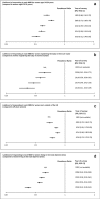Trends in response rates and respondent characteristics in five National Maternity Surveys in England during 1995-2018
- PMID: 32509303
- PMCID: PMC7249643
- DOI: 10.1186/s13690-020-00427-w
Trends in response rates and respondent characteristics in five National Maternity Surveys in England during 1995-2018
Abstract
Background: The National Perinatal Epidemiology Unit in England has conducted five National Maternity Surveys (NMS) at varying intervals since 1995. This paper aims to describe the changes in NMS response rates over time and to compare the demographic characteristics of respondents to each NMS.
Methods: This paper is based on secondary data analysis of the NMS (cross-sectional postal surveys) from 1995 to 2018. All women aged 16 years and over who gave birth in England (and Wales in 1995) during specified time periods from 1995 to 2018 were eligible to be selected. For each survey, between 3570 and 16,000 women who were 3-6 months postpartum were selected at random by the Office for National Statistics, using birth registrations. Women could participate on paper, by telephone (from 2006) or online (from 2010).
Results: The response rate to the NMS decreased from 67% in 1995 to 29% in 2018. The decline was evident across demographic groups. In all NMS, response rates were higher in women who were older (crude prevalence ratios (PR) for 16-24 years versus 30-34 years = 0.51-0.73 (across surveys)), married (crude PR for sole versus married registrants = 0.41-0.62), born in the UK (crude PR for non UK-born versus UK-born = 0.70-0.84), and living in less deprived areas (crude PR for least versus most deprived = 0.42-0.63). However, the association between each demographic characteristic and response varied across surveys, with the youngest women, women who registered the birth of the baby in their sole name, and women living in the most deprived areas becoming relatively less likely to respond over time. In multivariable analysis in 2014 and 2018, the effects of age, marital status, country of birth and level of area deprivation on response were attenuated but all four demographic characteristics remained statistically significantly associated with response.
Conclusions: Response rates to the NMS have declined significantly during the last 23 years. The demographic characteristics associated with response were consistent across surveys, but the size of the effect varied significantly, with underrepresented groups becoming relatively less likely to participate over time. It is important to find strategies to increase response rates, particularly amongst underrepresented groups, and to validate the data collected.
Keywords: Maternity survey; Survey response rate.
© The Author(s) 2020.
Conflict of interest statement
Competing interestsThe authors have no competing interests to declare.
Figures


Similar articles
-
Disparities in who is asked about their perinatal mental health: an analysis of cross-sectional data from consecutive national maternity surveys.BMC Pregnancy Childbirth. 2023 Apr 27;23(1):263. doi: 10.1186/s12884-023-05518-4. BMC Pregnancy Childbirth. 2023. PMID: 37101310 Free PMC article.
-
Impact of sampling and data collection methods on maternity survey response: a randomised controlled trial of paper and push-to-web surveys and a concurrent social media survey.BMC Med Res Methodol. 2023 Jan 12;23(1):10. doi: 10.1186/s12874-023-01833-8. BMC Med Res Methodol. 2023. PMID: 36635637 Free PMC article. Clinical Trial.
-
Methods to increase response rates to a population-based maternity survey: a comparison of two pilot studies.BMC Med Res Methodol. 2019 Mar 20;19(1):65. doi: 10.1186/s12874-019-0702-3. BMC Med Res Methodol. 2019. PMID: 30894130 Free PMC article.
-
Breastfeeding rates in England during the Covid-19 pandemic and the previous decade: Analysis of national surveys and routine data.PLoS One. 2023 Oct 11;18(10):e0291907. doi: 10.1371/journal.pone.0291907. eCollection 2023. PLoS One. 2023. PMID: 37819882 Free PMC article.
-
Prevalence and factors associated with postpartum posttraumatic stress in a population-based maternity survey in England.J Affect Disord. 2021 Jan 15;279:749-756. doi: 10.1016/j.jad.2020.11.102. Epub 2020 Nov 16. J Affect Disord. 2021. PMID: 33234280 Free PMC article.
Cited by
-
Exploring the knowledge of community-based nurses in supporting parents of preterm babies at home: A survey-based study.Nurs Open. 2022 May;9(3):1883-1894. doi: 10.1002/nop2.937. Epub 2021 May 19. Nurs Open. 2022. PMID: 34009710 Free PMC article.
-
Strategies to Increase Response Rate and Reduce Nonresponse Bias in Population Health Research: Analysis of a Series of Randomized Controlled Experiments during a Large COVID-19 Study.JMIR Public Health Surveill. 2025 Jan 9;11:e60022. doi: 10.2196/60022. JMIR Public Health Surveill. 2025. PMID: 39791251 Free PMC article. Clinical Trial.
-
OASI2: a cluster randomised hybrid evaluation of strategies for sustainable implementation of the Obstetric Anal Sphincter Injury Care Bundle in maternity units in Great Britain.Implement Sci. 2021 May 22;16(1):55. doi: 10.1186/s13012-021-01125-z. Implement Sci. 2021. PMID: 34022926 Free PMC article. Clinical Trial.
-
Survey Response Rates to a Self-Initiated Longitudinal Survey Accessed by a Quick Response Code in Six Different Regions of the United States.Cureus. 2022 May 19;14(5):e25146. doi: 10.7759/cureus.25146. eCollection 2022 May. Cureus. 2022. PMID: 35747044 Free PMC article.
-
Disparities in who is asked about their perinatal mental health: an analysis of cross-sectional data from consecutive national maternity surveys.BMC Pregnancy Childbirth. 2023 Apr 27;23(1):263. doi: 10.1186/s12884-023-05518-4. BMC Pregnancy Childbirth. 2023. PMID: 37101310 Free PMC article.
References
-
- Fuller E, Mindell J, Prior G. Health survey for England 2017. London: NHS Digital; 2018.
-
- NHS England. GP Patient Survey: surveys and reports. NHS England; 2018. Available from: http://www.gp-patient.co.uk/surveysandreports. Accessed 18 October 2019.
-
- Care Quality Commission. Maternity service surveys. Available from: https://www.cqc.org.uk/publications/surveys/maternity-services-survey-2018. Accessed 18 October 2019.
-
- Dillman DA, Smyth JD, Christian LM. Internet, phone, mail, and mixed-mode surveys: the tailored design method. 4. New Jersey: John Wiley & Sons; 2014.
LinkOut - more resources
Full Text Sources
Research Materials

